In Pennsylvania, there are a variety of different spider species, but this article will cover 51 that you can find in the state. Many people fear spiders, but most species are harmless and are actually a benefit to the environment they live in.
The thousands of spiders that live in the world are one of the earth’s greatest forms of natural pest control and help maintain the population of various insect populations. Spiders are also eaten by animals like lizards, birds, and rodents, and used as food for valuable nutrients.
This article will take a look at 51 spiders in Pennsylvania, and everything you should know about them. Spiders are abundant for most of the year, and each species has its own preference for when it prefers to be active.
Let’s take a look at the spiders in Pennsylvania that you may come across if in the state.
Table of Contents
Spiders in Pennsylvania
1. Orchard Orbweaver

- Experience Level: Intermediate
- Family: Tetragnathidae
- Scientific Name: Leucauge venusta
- Other Names: Orchard spider
- Adult Size: 3.5 to 7.5 mm (0.13 to 0.29 inches)
- Lifespan: 1 year
- Average Price Range: $20
The orchard orb weaver is a colorful species, found in Pennsylvania, and other states in the eastern United States.
This spider lives in highly vegetated places, such as orchards. Females build circular webs, while males spend their time looking for a mate.
Bushes, shrubs, and trees are common in the areas they live. Habitats such as urban areas, and woodlands are where you might spot this species.
Orchard orb weaver males are smaller than females, by around 2 mm in size, and also have a dull brown or cream coloring. Females have large elongated abdomens and spindly legs. They have a green coloring, with red and yellow markings on their body.
This spider feeds on small insects that get caught in its web and use its venom to neutralize them. Like many of the other spiders in Pennsylvania, this species is harmless.
Orchard orb weavers are most active in the months of summer and fall.
2. Red-spotted Orbweaver

- Experience Level: Intermediate
- Family: Araneidae
- Scientific Name: Araneus cingulatus
- Other Names: n/a
- Adult Size: 2 to 6 mm (0.1 to 0.24 inches)
- Lifespan: 1 year
- Average Price Range: n/a
The red-spotted orbweaver is a small species that inhabit Pennsylvania, and other areas within the United States.
Red-spotted orbweavers are active mostly in the summer and fall months and are seen less often than other species of the same family. This spider lives in vegetated areas, and its coloring helps it camouflage into its terrain.
Red-spotted orbweavers have a vibrant green coloring that makes them look as if they can glow in the dark. Females and males look similar, but females have larger abdomens than males, while males have longer legs. Bright yellow, orange, and reddish spots appear on this species’ abdomen, and small hairs cover their legs.
The red-spotted orbweavers live on plants, and other vegetation, feeding the insects that are around them. The size and camouflage of this species help them avoid predators like birds, lizards, and larger spiders.
3. Marbled Orbweaver

- Experience Level: Intermediate
- Family: Araneidae
- Scientific Name: Araneus marmoreus
- Other Names: Pumpkin spider
- Adult Size: 9 to 22 mm (0.35 to 0.86 inches)
- Lifespan: 1 year
- Average Price Range: $20
Marbled orbweavers are a species named after the marbled pattern that sits on the orbweaver’s back.
A nocturnal species, adults are seen most often in the summer and early fall months. Females of this species build large circular webs, while males spend their time looking for the webs of these females to mate.
The color of the marbled orb weaver can be orange, yellow, tan, light yellow, and reddish purple. Females have large bulbous abdomens, while males are much smaller with a sleeker appearance.
The legs of this spider are covered in dark banded markings, and they have small thin hair on them. The Mottled marbled pattern on their abdomen is their most identifying trait.
Marbled orb weavers feed on small flying insects that get caught in their web. They use their venom to immobilize their prey and ambush them quickly.
This species is not aggressive to humans and will flee if disturbed.
4. Furrow Spider
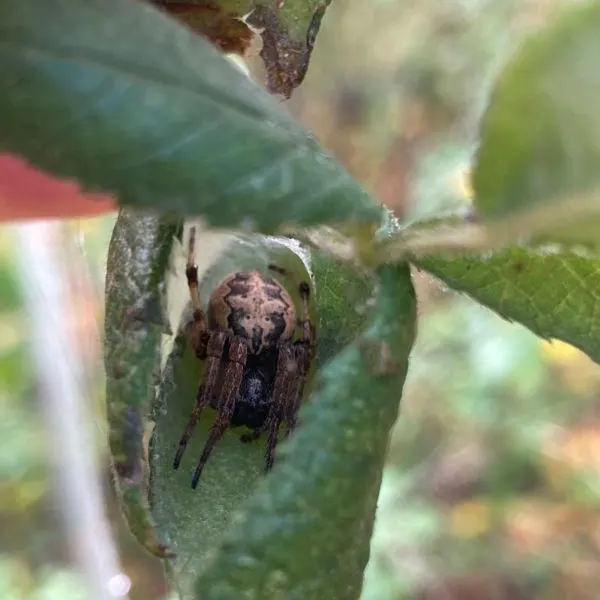
- Experience Level: Beginner
- Family: Araneidae
- Scientific Name: Larinioides cornutus
- Other Names: Furrow orb weaver
- Adult Size: 10 to 12 mm (0.39 to 0.47 inches
- Lifespan: 1 year
- Average Price Range: n/a
The furrow orb weaver is a spider named after the furrow-shaped pattern that appears on its back.
This species has tan coloring and dark black markings running down the center of its back. Furrow orb weavers have rounded abdomens and thick legs with a dark brown banded pattern on them.
Furrow orb weavers live in densely vegetated areas with plants like low grass, or shrubs. Each evening this spider rebuilds its web for the night and gets it ready to catch more insects. These species are active from spring to fall and are seen most in the warm months of summer.
Spring and autumn is the mating season for the furrow orb weaver in Pennsylvania. This species uses a cocoon and pheromones to mate. Males and females can be seen sitting on the same web during mating season. Furrow orb weavers are not seen in the winter and become inactive.
5. Bridge Orbweaver

- Experience Level: Intermediate
- Family: Araneidae
- Scientific Name: Larinioides sclopetarius
- Other Names: n/a
- Adult Size: 8 to 14 mm (0.31 to 0.55 inches)
- Lifespan: 1 to 2 years
- Average Price Range: n/a
Bridge orb weavers are a spider that gets their name since it is regularly found on bridges and other man-made structures in their preferred habitats. Places with lots of vegetation and humidity are where they prefer to live.
This spider lives in a circular web and is found near light sources like street lamps or porch lights. Bridge orb weavers are active mostly in the summer, and are nocturnal spiders.
The bridge orb weaver has gray coloring, with a dark brown mottled pattern on its body. The legs have yellow, and gray bands on them, and many small hairs cover their body. Males of this species have larger legs, while females have more robust bodies.
The night is when the bridge orb weaver feeds on flying insects like flies, gnats, and moths. By living near porch lights this spider gets access to the insects that are also attracted to the light.
6. Arabesque Orbweaver
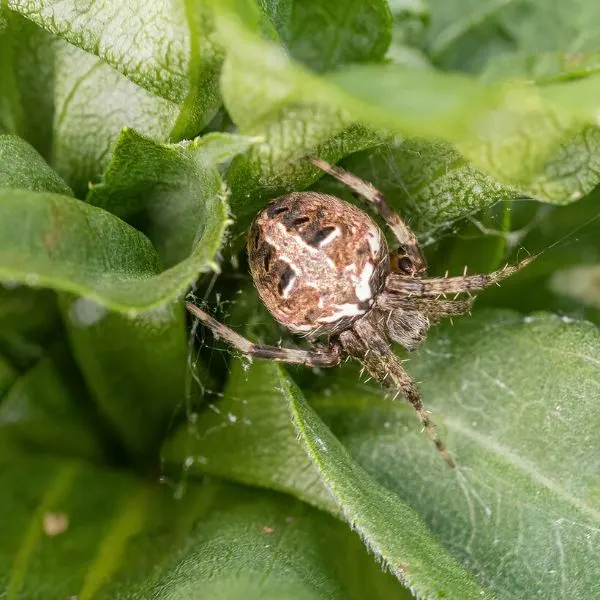
- Experience Level: Intermediate
- Family: Araneidae
- Scientific Name: Neoscona arabesca
- Other Names: n/a
- Adult Size: 5 to 7 mm (0.19 to 0.27 inches)
- Lifespan: 1 year
- Average Price Range: n/a
The Arabesque orb weaver is a species named after the swirling pattern that appears on this spider’s back.
Active mostly in the summer and early fall months, arabesque orb weavers are seen the most and live in large circular webs. Only females create these webs and they also eat their own silk to recycle their webbing.
Arabesque orb weavers have a tan, yellow, brown, orange, or dark brown coloring, and a swirling arabesque pattern on the back of their rounded abdomen. Females are much larger than the males of this species.
Males have longer legs and are smaller-bodied. Arabesque orb weavers have small hairs covering their bodies which help them navigate their web.
Flying insects like mosquitoes, gnats, and flies are what this species feeds on, catching the bugs that get caught in their web. This spider is active at night and spends the night avoiding predators like other spiders that will feed on them.
7. Hentz Orbweaver
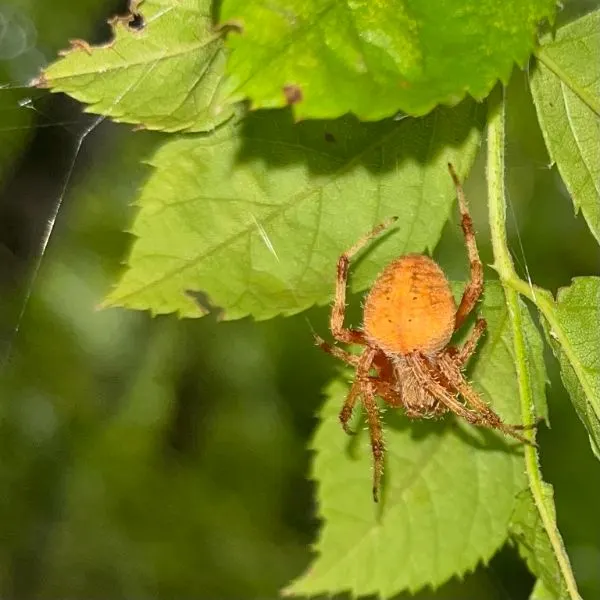
- Experience Level: Intermediate
- Family: Araneidae
- Scientific Name: Neoscona crucifera
- Other Names: Spotted orbweaver
- Adult Size: 5 to 20 mm (0.19 to 0.78 inches)
- Lifespan: 1 year
- Average Price Range: n/a
A common species in woodland and moist forest habitats, the Hentz orb weaver is a spider in Pennsylvania known to build large circular webs that other orb weavers build.
This species is nocturnal, but in the fall females can be seen sitting in their web during the day. It is said females do this in the fall since they are trying to feed on more insect prey to have better success at laying more eggs.
The Hentz orb wear is a grayish or olive color, with a mottled pattern on their body. Their legs and body are covered in small thick hairs. Males are smaller than females but have similar colors.
Hentz orb weavers are commonly to find on man-made structures like sheds, barns, and the side of houses. Summer and fall are when this spider is most active.
Hentz orb weavers feed on insects like flies, and beetles that get caught in their web, and rebuild their webs around dawn or dusk.
8. European Garden Spider

- Experience Level: Intermediate
- Family: Araneidae
- Scientific Name: Araneus diadematus
- Other Names: Cross Spider
- Adult Size: 5.5 to 20 mm (0.2 to 0.7 inches)
- Lifespan: 1 year
- Average Price Range: n/a
European garden spiders are native to Europe as their name suggests, but this species is a spider found in Pennsylvania and other states across the US.
This spider builds its web in areas with high vegetation. This species is mostly seen in the fall when it mates.
Females are able to lay up to 900 eggs and hide them in secluded areas where they won’t get disturbed. Their egg sacs have a yellow color and contain the spiders that will populate the wild next spring.
European garden spiders are also called cross spiders because of the white pattern that appears on the back of their abdomen. This spider has white blotches on its body, with some in the shape of a cross. They have an orange or brown base color, and long spindly legs.
Insects that get caught in this spider’s web are what they feed on. The morning is when their web is built, and they are known to eat their own silk to recycle their webbing.
9. Shamrock Orbweaver

- Experience Level: Intermediate
- Family: Araneidae
- Scientific Name: Araneus trifolium
- Other Names: Shamrock spider
- Adult Size: 19 mm (0.74 inches)
- Lifespan: 1 year
- Average Price Range: n/a
The shamrock spider is a species that lives across the United States and Canada. This species creates webs that are circular shaped, and are around 60 cm in diameter.
This species lives in humid areas and is found in habitats like urban areas, forests, gardens, and grasslands. They are sometimes found in large buildings like garages or homes.
Shamrock spider females have large bulbous abdomens and come in different colors like orange, brown, white, or gray. The abdomen of this spider has white blotches on it. Small hairs cover this spider’s body, and their legs and dark bands that appear on them.
This species is venomous, but their bites are harmless to humans unless allergic. Their venom is only useful in killing their prey which is small insects.
This spider was for things to get caught in their webs, and fed on things like flies, gnats, and moths. Shamrock orb weavers are one of the most common species in their range and are active mostly in the summer and fall months.
10. White Micrathena
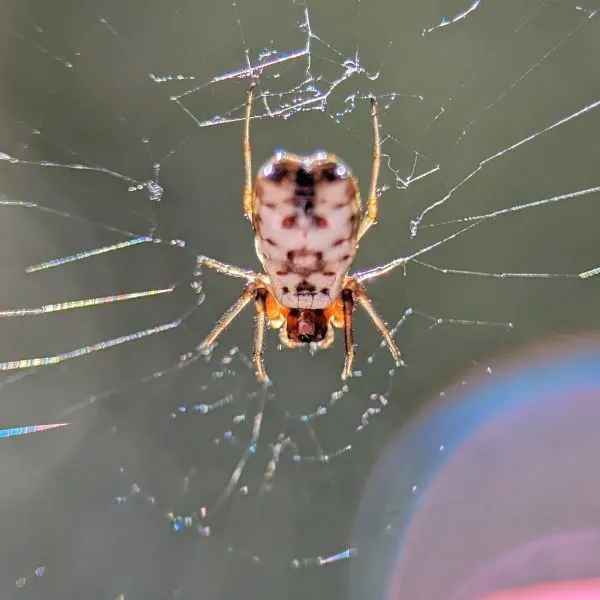
- Experience Level: Intermediate
- Family: Araneidae
- Scientific Name: Micrathena mitrata
- Other Names: Spiny orbweavers
- Adult Size: 4.2 to 10.8 mm (0.16 to 0.42 inches)
- Lifespan: 1 year
- Average Price Range: n/a
The white micrathena is a small spider that lives in Pennsylvania, and other regions across North America.
This spider has a white abdomen in the shape of a head wrap and builds circular webs to live in similar to other orb weaver species. White micrathena have black spikes on the tip of their abdomen.
White micrathena build new webs every week and spend their life wandering from place to place. They feed mainly on insects and build their webs in places with lots of plant life and insect traffic.
White micrathena is a harmless species and is used for food by birds, and lizards. The bite of this spider is harmless, and this species is great to have around gardens as it reduces the population of plant-eating bugs.
11. Spined Micrathena
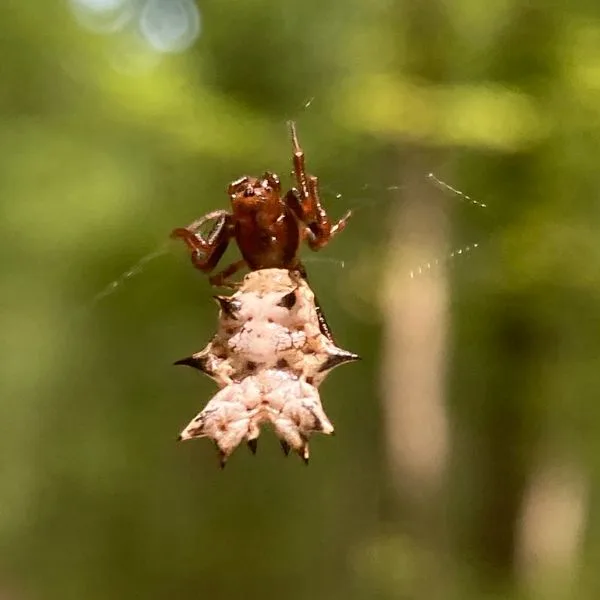
- Experience Level: Intermediate
- Family: Araneidae
- Scientific Name: Micrathena gracilis
- Other Names: Castleback orbweaver
- Adult Size: 4 to 10 mm (0.15 to 0.31 inches)
- Lifespan: 1 year
- Average Price Range: n/a
Spined micrathena are native to North and Central America. This spider can be found in Pennsylvania and lives in forest-type habitats.
They live in woodland habitats that are near freshwater sources like rivers, ponds, lakes, and wetlands. When flooding occurs these spiders mate. Spring to fall is when these spiders are active, becoming dormant in the winter period.
Spined micrathena have large white abdomens, with dark spines that protrude from their body. The body has black, yellow, and orange spots on it, and their body.
The black spines that appear out of this species’ body are one of its most identifiable traits, but males are much smaller in size and do not have these traits. Male spined micrathena have tan coloring, with a small elongated abdomen.
This spider feeds on small insects it comes across or the ones that get caught in its web. Females create large circular webs that catch insects, while males spend their time looking for a female to mate with.
This spider is harmless, and its small size makes them prey for animals like birds.
12. Arrow-shaped Micrathena

- Experience Level: Intermediate
- Family: Araneidae
- Scientific Name: Micrathena sagittata
- Other Names: n/a
- Adult Size: 5 to 9 mm (0.20 to 0.35 inches)
- Lifespan: 1 year
- Average Price Range: n/a
One of the more interesting looking spiders in Pennsylvania, arrow-shaped micrathena is named after its arrow-like body shape. This spider has two large spines that protrude out the back of its yellowish abdomen and red legs.
Males of this species are much smaller in size and lack a spiny appearance. They are all black, and rarely seen.
Arrow Shaped micrathena are mostly found in the eastern United States and live in very vegetated areas. Places like gardens, woodlands, and wetlands are a few places this species is found. They are mostly seen in the summer and fall months but become active in the spring.
This spider feeds on small insects and is also used as food for animals like birds or waps. The spines on this species’ body help ward off predators, but it does not always work.
Arrow-shaped micrathena are harmless, and only have weak venom that is only useful on small insects.
13. Black and Yellow Garden Spider

- Experience Level: Intermediate
- Family: Araneidae
- Scientific Name: Argiope aurantia
- Other Names: Yellow garden spider
- Adult Size: 5 to 28 mm ( 0.2 to 1.1 inches)
- Lifespan: 1 year
- Average Price Range: $8
A large orb-weaving species you can find in Pennsylvania, the black and yellow garden spider is a very common species that live across the United States.
This spider is mostly seen in the warm months of summer and fall. They live in vegetated areas like gardens, and fields, and build webs supported by the surrounding plants.
Females are the sex of this spider that builds webs. Males are sometimes found in a female’s web to mate and are much smaller than their counterparts.
Females are one of the largest members of the Araneida family that lives in Pennsylvania and are named after their black and yellow coloring. Females have round abdomens and are long with black and yellow coloring on them.
During the day this large spider can be seen sitting in its web, waiting for insects to get caught. Birds and wasps are this spider’s biggest threats, but being so large they are active in the day more often unlike other orbweavers.
14. Banded Garden Spider

- Experience Level: Intermediate
- Family: Araneidae
- Scientific Name: Argiope trifasciata
- Other Names: Banded orb-weaving spider
- Adult Size: 15 to 25 mm (0.59 to 0.98 inches)
- Lifespan: 1 year
- Average Price Range: n/a
The banded garden spider is a large orbweaver species named after the white, black, and yellow bands that appear on its body.
Females are much larger than males and have oval-shaped abdomens with spindly legs. Males are much smaller in size and look like miniature versions of females.
Banded garden spiders live in grassy habitats with plenty of other plant life like shrubs, bushes, and trees. They build large circular webs and make a zig-zag pattern that runs down the center of it occasionally. Summer and fall are when the banded garden spider is most active, and they become inactive in the winter until spring.
Being a larger species this spider may seem scary, but it is relatively harmless. They are only dangerous to the insects that get caught in their webs like moths, dragonflies, and beetles.
Bites from this spider are only venomous to the small bugs they feed on, and fleeing is what they do most often if provoked.
15. White-jawed Jumping Spider

- Experience Level: Beginner
- Family: Salticidae
- Scientific Name: Hentzia mitrata
- Other Names: Crowned Hentzia
- Adult Size: 3 to 5 mm ( 0.11 to 0.19 inches)
- Lifespan: 1 year
- Average Price Range: n/a
A small and agile species, the white-jawed jumping spiders are native to the United States and are also found in Canada. This species lives in a variety of habitats like forests, urban areas, and grassland.
They are active during the day. Being a jumping spider this species moves by leaping quickly, and will most likely feel if approached.
White-jawed jumping spiders have white coloring and small hairs on them. Females are mostly white with a mottled pattern of brown on them. Males have orange markings on their abdomen and the top of their head and have frog legs much longer than the rest of the other legs.
White-jawed jumping spiders feed on small insects and pounce on the prey they find. Aphids, small beetles, and flies are some of the things they eat. This spider stalks its prey like a cat and circles them until the right time to jump.
16. Dimorphic Jumping Spider

- Experience Level: Beginner
- Family: Salticidae
- Scientific Name: Maevia inclemens
- Other Names: n/a
- Adult Size: 4.75 to 8 mm (0.187 to 0.31 inches)
- Lifespan: 1 year
- Average Price Range: $20 to $30
A species named after its multiple looks, the dimorphic jumping spider is a small spider living in Pennsylvania.
Dimorphic jumping spiders are active during the day and spend their time roaming about in urban areas, fields, gardens, and woodland areas. When night comes this spider builds a silk retreat to rest in.
This spider is called dimorphic since males are able to appear in two different morphs. Males of this species are either black or have a gray mottled pattern on them.
Females have a tan coloring, with a mottled pattern on them and a larger abdomen. Dimorphic jumping spiders have the eyes, and body shape of other jumpings spiders, with angular legs that help them leap.
This spider feeds on small insects it comes across, ambushing them when close enough. Dimorphic jumping spiders are found mainly in the eastern United States and spend their day wandering.
17. Ribbon Jumping Spider
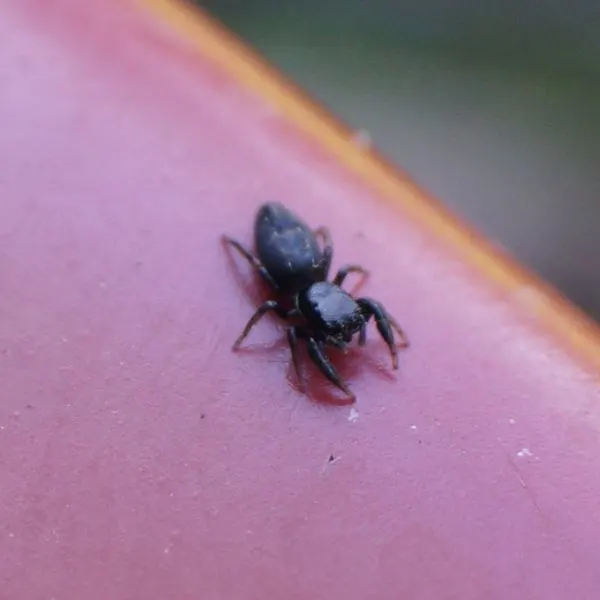
- Experience Level: Beginner
- Family: Salticidae
- Scientific Name: Metacyrba taeniola
- Other Names: n/a
- Adult Size: 4.4 to 7.2 mm (0.17 to 0.28 inches)
- Lifespan: 1 year
- Average Price Range: n/a
Ribbon jumping spiders are small Salticidae found in Pennsylvania and other states within the eastern United States.
Like other jumping spiders this species is active during the day, and spends its time wandering on vertical surfaces. Ribbon-jumping spiders are active in the spring and fall, and in the winter this spider becomes inactive.
Ribbon jumping spiders have black coloring with dark brown legs. This spider has small yellow spots that appear on its body, and two lines that run down them.
Ribbon-jumping spiders have two large front eyes that give them excellent vision. This spider is harmless and flees before biting.
Bites from this spider and other jumping spiders are harmless unless you are allergic to the venom. Small insects are what this spider feeds on, and they pounce on their prey when they are least suspecting it.
18. Bold Jumping Spider

- Experience Level: Begidarker
- Family: Salticidae
- Scientific Name: Phidippus audax
- Other Names: Daring jumping spider
- Adult Size: 6 to 19 mm (0.23 to 0.74 inches)
- Lifespan: 1 year
- Average Price Range: $20 to $30
Named after its bold coloring, the bold jumping spider is a large species of Salticidae and is also one of the most common in the US.
This species is commonly found on vertical surfaces and is active during the day. While this spider does not build a web to live in like an orb weaver, they use its silk as a tether when traveling to prevent death if they fall.
Bold jumping spiders have black coloring, with white tufts of hair on their legs. On the back of their abdomen, this spider has white dots that appear on the abdomen, but for younger spiders, these markings appear orange.
The chelicerae of this species have green coloring, with an iridescent shine to them. Various insects like worms, moths, and flies make up this spider’s diet.
Harmless to humans, a bite from this spider only has mild symptoms like slight pain and swelling. Jumping spiders like this species do not bite often even if handled, which is one reason why they make good pets.
19. Peppered Jumping Spider
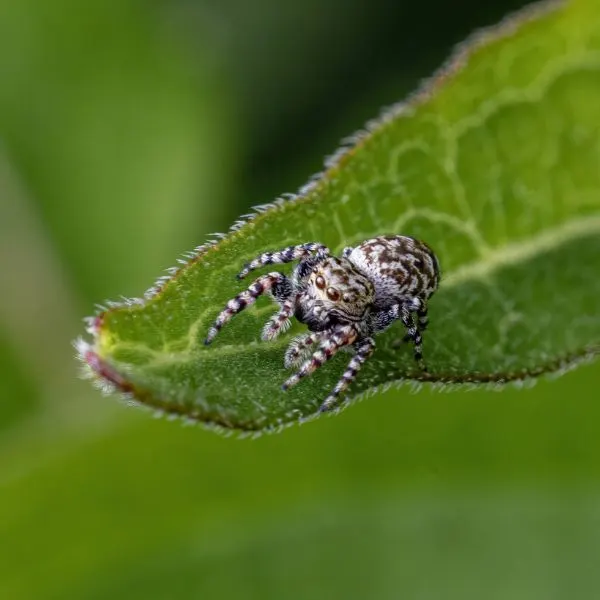
- Experience Level: Beginner
- Family: Salticidae
- Scientific Name: Pelegrina galathea
- Other Names: n/a
- Adult Size: 2.7 to 5.4 mm (0.1 to 0.21 inches)
- Lifespan: 1 to 2 years
- Average Price Range: n/a
Peppered jumping spiders are named after the black and white mottled coloring that covers their body.
This species is sexually dimorphic, as males have a slightly darker coloring than females. Both sexes are around the same size and are one of the smaller Salticidae in Pennsylvania.
Peppered jumping spiders live in grassy areas with plenty of sunlight. Grasslands, gardens, parks, and backyards are a few of the places this spider is found.
This spider is native to North America and has a range stretching from Canada to Costa Rica. Spring to fall is when you may see these spiders, and they are active during the day.
Small insects like gnats, flies, and aphids are what this species feeds on. They hunt during the day by staking their prey with their excellent eyesight.
Vertical surfaces are used by jumping spiders to look for prey, and their eyesight is among the best in spiders.
20. Magnolia Green Jumping Spider

- Experience Level: Beginner
- Family: Salticidae
- Scientific Name: Lyssomanes viridis
- Other Names: n/a
- Adult Size: 5 to 8 mm (0.19 to 0.31 inches)
- Lifespan: 1 year
- Average Price Range: n/a
Magnolia green jumpers are a vibrant green species and look similar to the colorful green lynx spider.
This species is a member of the Salticidae family, common in highly vegetated areas. Grassy fields, meadows, and woodlands are where this species can be found, moving around on vegetation.
Magnolia green jumpers are a small species, with green coloring that looks like they can grow in the dark. A pale translucent green spider, this species easily blends into the plant life it moves around on.
A diurnal species, magnolia green jumpers spend their time hunting small insects like aphids and ants. They are preyed on by larger spiders, and lizards most often.
Sunny days in the spring and summer months are when this spider is most active.
21. Tan Jumping Spider

- Experience Level: Beginner
- Family: Salticidae
- Scientific Name: Platycryptus undatus
- Other Names: n/a
- Adult Size: 8.5 to 13 mm (0.33 to 0.51 inches)
- Lifespan: 1 year
- Average Price Range: $20 to $30
Tan jumping spiders are a common species found across the United States and inhabit Pennsylvania.
This spider is active in a variety of habits and is often seen on vertical surfaces like fences, trees, or the sides of houses. Tan jumping spiders leap from place to place and use a line of silk to keep safe when jumping.
This spider’s color ranges from dark brown to tan. They have tiny hairs covering them, and some of the best eyes in the spider kingdom.
Tan jumping spiders and other similar species have two large eyes in the front of their face giving them binocular vision. Smaller eyes circle their head making their total vision nearly 360 degrees.
Tan jumping spiders use their excellent vision and fast movements to hunt small insects during the day. This spider also faces predators like larger spiders such as the lynx spider, birds, and lizards in the wild.
22. Zebra Jumping Spider

- Experience Level: Beginner
- Family: Salticidae
- Scientific Name: Salticus scenicus
- Other Names: Zebra Jumper
- Adult Size: 5 to 9 mm (0.19 to 0.35 inches)
- Lifespan: 1 year
- Average Price Range: $20 to $30
The zebra jumping spider is a black and white species, named after its zebra-like appearance. This spider can be found in Pennsylvania and has a large range across North America and Europe.
This species is active during the day and spends its time wandering around vertical surfaces. On beaches, forests, and urban places are where this spider is sometimes found.
The black-and-white coloring of this species is found in both sexes. Males have dark coloring but females are slightly smaller. Small hairs cover this spider’s body, and they have angular legs to help them leap quickly similar to other jumping spiders.
Jumping spiders like this species have excellent eyesight due to their eye placement. The two front eyes of this species are large, and smaller ones circle their heads like a crown. Jumping spiders have nearly 360 degrees of range in their vision, and also binocular vision to judge depth.
Flies, other smaller spiders, and beetles are a few of the small animals this species feeds on. They use their keen vision and quick leaps to take out their prey.
Zebra jumping spiders are harmless to humans, and if they spot you they will most likely flee. Like other similar species, this spider will make a good pet due to its simple diet, and harmless nature.
23. Hammer-jawed Jumper

- Experience Level: Beginner
- Family: Salticidae
- Scientific Name: Zygoballus rufipes
- Other Names: n/a
- Adult Size: 3 to 6 mm (0.11 to 0.23 inches)
- Lifespan: 1 year
- Average Price Range: n/a
The hammer-jawed jumping spider is a small species, usually found in wooded areas among vegetation. Found in Pennsylvania and other areas in the United States.
They also inhabit places such as Costa Rica, Guatemala, Canada, and Mexico. This species was first described in 1885 and is a spider you may find in the day. The northeastern United States is where this species is most common, in the months from spring to fall.
This species is sexually dimorphic, with females having much more robust bodies than males. The male hammer-jawed jumping spider has a black head, with a small brown abdomen.
Females have small hairs covering their bodies and white coloring with a dark mottled pattern on them. This spider has large eyes and forward-facing jaws.
Grasslands, woodlands, and backyards are some of the areas in which these species are found. They hunt during the day and feed on small insects in vegetation like aphids or gnats.
Larger spiders, lizards, and birds are the main predators this small spider faces in the wild.
24. Brilliant Jumping Spider

- Experience Level: Beginner
- Family: Salticidae
- Scientific Name: Phidippus clarus
- Other Names: n/a
- Adult Size: 3 to 4 mm ( 0.11 to 0.15 inches)
- Lifespan: 6 months to 2 years
- Average Price Range: n/a
The brilliant jumping spider lives across North America and is a species found in Pennsylvania. This spider lives in open habitats like fields, grasslands, and open woodlands.
This spider is most active in the Summer and early fall months. Brilliant jumping spiders are active during the day, and at night they build a silk cocoon to rest in.
Summer is when this spider mates and lays eggs and females lay eggs in the fall. Males find females by sensing their pheromones and court the female by dancing and waving their arms.
Female brilliant jumping spiders create egg sacs on vegetation and will guard them until the spiderlings disperse out into the wild. The brilliant jumping spider has a reddish abdomen, with black hair.
Males have white hairs on them, white females are covered in light brown hairs. Male brilliant jumping spiders have darker coloring and vibrant green chelicerae.
Wasps are the main predator that this species faces, but they are also eaten by other spiders. Brilliant jumping spiders spend their time in the day hunting small insects like flies, and pill bugs.
They use their fast leaps to jump on their prey, and they use a silk tether attached to things to prevent themselves from falling to their death.
25. Striped Lynx Spider

- Experience Level: Intermediate
- Family: Oxyopidae
- Scientific Name: Oxyopes salticus
- Other Names: n/a
- Adult Size: 4 to 7 mm (0.15 to 0.27 inches)
- Lifespan: 1 year
- Average Price Range: n/a
Found across North America, the striped lynx spider is a species living in Pennsylvania. This spider inhabits the eastern United States.
Grasslands, backyards, and woodlands are where this spider lives. They prefer vegetated areas and move nimbly across landscapes with their quick movements and silk. This species is active during the day and spends this time hunting.
Spring is when the lynx spider mates and they lay around 30 to 40 eggs. This species will create an egg sac on a surface, and the female will guard it. She defends the egg sac until the spiderlings hatch, and are ready to go on their own.
Striped lynx spiders look similar to jumping spiders, but longer and thinner legs. This spider has tan coloring, with a dark striped pattern on its body. Small hairs cover their legs, and they have eight eyes grouped on their small faces.
Lynx spiders are named for their speed and cat-like movements. They are able to quickly move and travel across their silk.
Striped lynx spiders feed on other spiders, flies, beetles, and other small animals they come across. Lizards and larger spiders are this species’ main predators.
26. Black Laceweaver
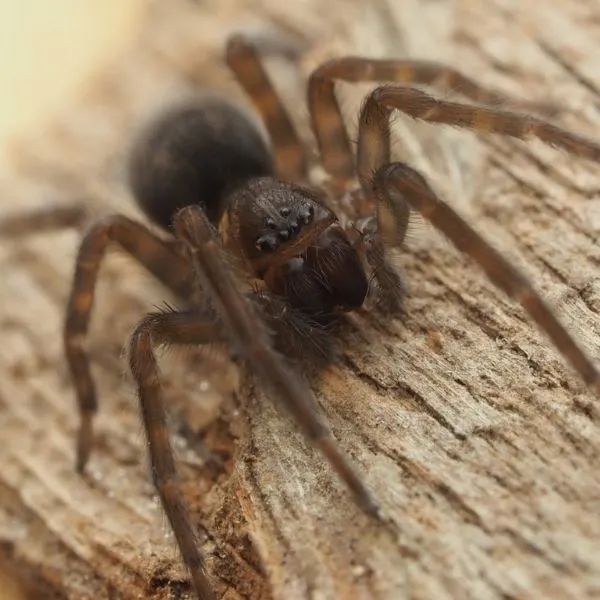
- Experience Level: Intermediate
- Family: Amaurobiidae
- Scientific Name: Amaurobius ferox
- Other Names: n/a
- Adult Size: 8 to 16 mm (0.31 to 0.62 inches)
- Lifespan: 1 to 2 years
- Average Price Range: n/a
Found across North America, the black lace weaver is a species that lives in dark and secluded areas. This spider builds its web with frayed lace-like silk, with a retreat for it to hide in.
Its webs are messy and made in crevices in fences, walls, underwater spigots, and other similar areas. Black lace weavers build their webs at night, and during the day this spider rests.
This species has a gray rounded abdomen, with a yellow mottled pattern on it. Their legs are long and large, with the strength to hold down and ambush their prey. Black lace weavers have large fangs and eight eyes in two rows on their faces.
Black lace weavers feed on insects like flies, crane flies, and other insects that walk into their web. They ambush their prey and pull them in to bite them when the prey gets close enough.
This spider is not seen often, but can sometimes be found sitting on the edge of its retreat. They are harmless to humans and rarely bite.
27. Barn Funnel Weaver

- Experience Level: Beginner
- Family: Agelenidae
- Scientific Name: Tegenaria domestica
- Other Names: Domestic house spider
- Adult Size: 6 to 11.5 mm (0.24 to 0.45 inches)
- Lifespan: 1 to 5 years
- Average Price Range: n/a
The barn funnel weaver is a common species found in Pennsylvania and other parts of the United States. This species is most active in the spring and live in funnel-like webs that they create.
Barn funnel weavers make their home in crevices like rocks, logs, and underboards, and on man-made structures like barns. They are not seen often and hide in their silk retreat for most of their life.
A small spider, this species has a base tan coloring, with dark markings that cover its body. Their legs are long and hairy, and let them easily traverse over their web. Females are larger bodies than males, while males have larger legs.
Barn funnel weavers are an extremely fast species and use their speed to catch prey that gets near their web. Their web is made with a funnel that they run out of to grab their prey, and they kill them with venom.
28. White-banded Crab Spider
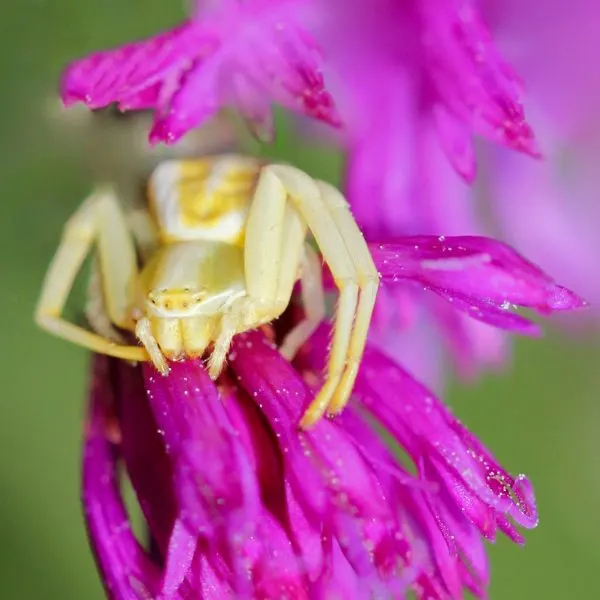
- Experience Level: Intermediate
- Family: Thomisidae
- Scientific Name: Misumenoides formosipes
- Other Names: n/a
- Adult Size: 3 to 11 mm (0.11 to 0.43 inches)
- Lifespan: 1 year
- Average Price Range: n/a
A flower crab spider found in Pennsylvania, the white-banded crab spider is a widespread species living across North America. This spider lives on flowering plants like daisies, and milkweed.
They are active mostly in the summer and fall months and live in habitats like meadows, woodlands, and grasslands. This spider is mostly seen in the northeastern US.
White-banded crab spider females spend their life on a flower, while males spend their time looking for a mate. To travel this species is able to balloon, which is where they use their silk on a windy day to catch the wind and travel. Females have large abdomens, while males have longer-looking legs.
White-banded crab spiders are named after the white band marking that appears on their cephalothorax. Females are able to change their color from yellow to white to be able to blend into the flower they are sitting on better.
This species feeds on pollinating insects like flies, butterflies, and bees. They grab their prey with their strong front legs and bite them to kill them.
29. Goldenrod Crab Spider
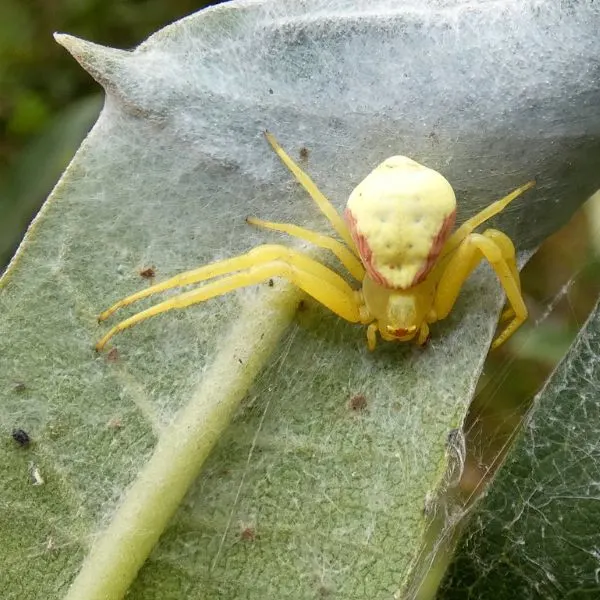
- Experience Level: Beginner
- Family: Thomisidae
- Scientific Name: Misumena vatia
- Other Names: Flower crab spider
- Adult Size: 5 to 10 mm (0.20 to 0.39 inches)
- Lifespan: 1 year
- Average Price Range: n/a
Living across North America the goldenrod crab spider is a common species. They live in Pennsylvania and are active mostly in the summer and fall months.
This species lives on flowering plants like goldenrods. Females only live flowers, while males look for a mate, and will guard their female until death.
Female goldenrod crab spiders have yellow or white coloring, while males have small abdomens with brown and white coloring female goldenrod crab spiders are able to change their color to match their surroundings, but this change happens slowly in around a month.
This spider feeds on insects like bees and butterflies since they visit flowers often. They grab their prey with their strong legs and crab-like claws.
30. American Green Crab Spider

- Experience Level: Beginner
- Family: Thomisidae
- Scientific Name: Misumessus oblongus
- Other Names: n/a
- Adult Size: 3 to 6.8 mm (0.12 to 0.27 inches)
- Lifespan: 1 year
- Average Price Range: n/a
The American green crab spider is a common species in Pennsylvania and other parts of North America. This spider lives in woodland and grassland areas.
Green crab spiders do not build webs but can be found on various vegetation. Silk is only used by males to tie up their mates, and by females to create sacs.
This species has long legs and green coloring. They have a crab-like appearance similar to other similar Thomisidae spiders.
This spider is active during the day and uses its green coloring to camouflage into its habitat. Its green coloring helps it hide from predators like other spiders and lizards.
American green crab spiders feed on insects like ants, butterflies, bees, and beetles. They grab their prey with their strong legs and overpower them.
Their prey is killed with their venom and held onto with their crab claws.
31. Long-palped Ant-mimic Sac Spider

- Experience Level: Intermediate
- Family: Corinnidae
- Scientific Name: Castianeira longipalpa
- Other Names: n/a
- Adult Size: 3 to 13 mm (0.11 to 0.51 inches)
- Lifespan: 1 to 2 years
- Average Price Range: n/a
Long-palped ant mimics replicate the behavior, and movement of ants. This species, like other ant mimics, walk with their two front legs up so they look like antennae.
They also move very slowly to walk more ant-like. Mimicking an ant helps this species get near ants, and prey on them. This spider lives in a variety of habitats like backyards, parks, grasslands, and woodland areas.
This spider has black coloring with a yellow or white cephalothorax. Their abdomen has light-colored marks, and their legs have light bands on them. This spider is a small species, with a sleek appearance.
Ants, larvae, and other small insects are what this species feeds on. They wander around to hunt and are active for most of the year.
32. Northern Yellow Sac Spider
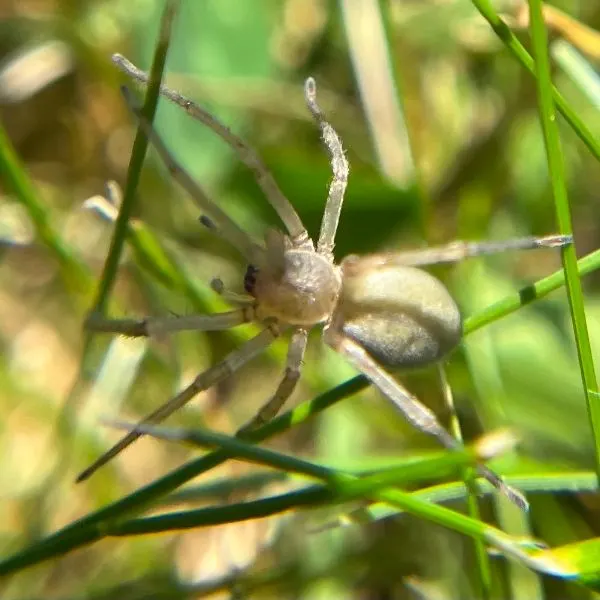
- Experience Level: Intermediate
- Family: Cheiracanthiidae
- Scientific Name: Cheiracanthium mildei
- Other Names: Long-legged Sac Spider
- Adult Size: 5 to 10 mm (0.19 to 0.39 inches)
- Lifespan: 1 to 2 years
- Average Price Range: n/a
Yellow sac spiders are common in Pennsylvania and are found across North America. This spider is also found in areas like Europe, Africa, and the Americas.
Spring and summer are when this species is most active, and they are able to live in various habitats. Woodlands, gardens, and other vegetated habitats are where this spider lives. They often make their way into homes and will hide under cardboard and dirty laundry piles.
Yellow sac spiders have cream or yellow coloring as their name suggests. They have long legs, a rounded abdomen, and a similar body shape to the brown recluse. Small hairs cover their body, and they have large dark fangs to kill their prey.
This spider is mildly venomous to humans, with necrotic venom. Pain, redness, and a lesion are symptoms because of their bite.
This species bites humans more than other species since they are regularly found in and around homes. Insects and other spiders are what they feed on, and they actively hunt for their food.
33. Broad-faced Sac Spider
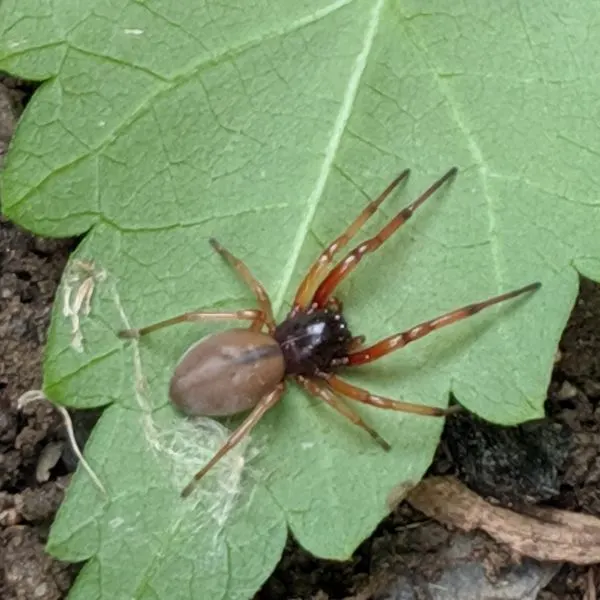
- Experience Level: Intermediate
- Family: Trachelidae
- Scientific Name: Trachelas tranquillus
- Other Names: n/a
- Adult Size: 5 to 10 mm (0.19 to 0.39 inches)
- Lifespan: 1 to 2 years
- Average Price Range: n/a
Pennsylvania is just one of the few states in the eastern United States where the broad-faced sac spider is found. They live in warm and humid environments and are most active in the heat of summer.
This spider is nocturnal, and during the day they build a sac retreat to rest in like other similar species. This spider gets its name from its large broad head, and it also has large fangs.
They have a gray abdomen, while the rest of their body has a reddish-brown coloring. This spider uses its large fangs to feed on insects like pill bugs, and beetles.
Bites from them can be painful due to their large fangs, but this species is harmless.
34. Garden Ghost Spider

- Experience Level: Intermediate
- Family: Anyphaenidae
- Scientific Name: Hibana gracilis
- Other Names: n/a
- Adult Size: 4 to 8 mm (0.15 to 0.31 inches)
- Lifespan: 1 year
- Average Price Range: n/a
The garden ghost spider has a ghost-like appearance and is a native species to North America.
This spider is nocturnal and lives in vegetated areas like gardens, grassland, woodlands, and parks. There are many species of ghost spiders, and they are active from the spring to fall months.
This spider has beige or white coloring similar to a ghost. They have small hairs that cover their body, and body types that resemble other wandering sac spiders.
This species spends its time hunting at night, and in the day they hide in secluded areas like under rocks or logs. A harmless species, like a ghost you may not even notice when this spider is near.
35. Woodlouse Spider
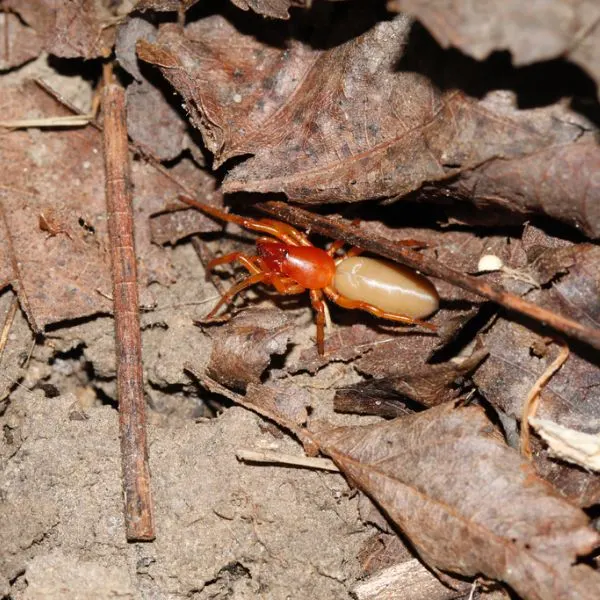
- Experience Level: Beginner
- Family: Dysderidae
- Scientific Name: Dysdera crocata
- Other Names: Woodlouse hunter, sowbug killer
- Adult Size: 9 to 3 mm (0.35 to 0.59 inches)
- Lifespan: 2 to 5 years
- Average Price Range: n/a
The woodlouse spider is a species that gets its name since it is regularly found near woodlice, and eats them often.
This spider is a widespread species found in Pennsylvania and is more often seen in the eastern United States. Woodlouse spiders are active year-round, and in the colder seasons, they make their way into homes.
This spider has a large red head and fangs, with a tan rounded abdomen. Their legs also have red coloring. Females look the same as males but have thicker legs and larger abdomens.
The fangs of this species are large and deliver a painful bite. The venom of this species is harmless, but since they feed on dead animals medical treatment is recommended if a bit.
Woodlice are the main food for this species since they spend most of their life in dark and moist areas inhabited by them. They also feed on other small animals they come across like earwigs, and other spiders if they happen to come across them.
Woodlice are their primary food source, and their large fangs are useful for piercing the armored body of woodlice.
36. Eastern Parsons Spider
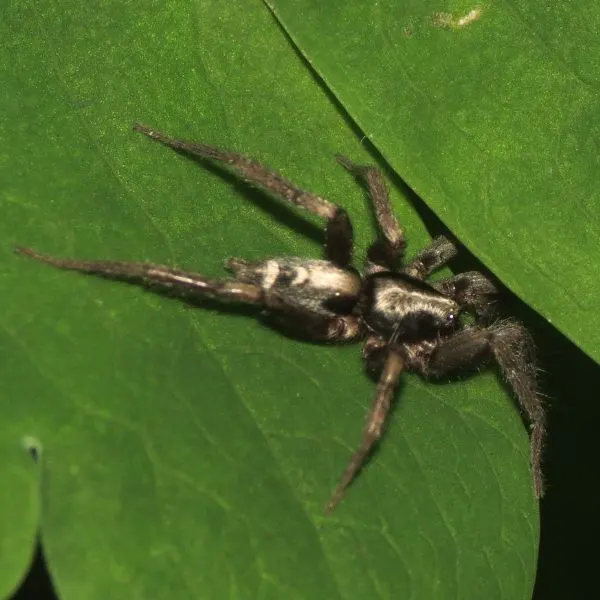
- Experience Level: Intermediate
- Family: Gnaphosidae
- Scientific Name: Herpyllus ecclesiasticus
- Other Names: n/a
- Adult Size: 5 to 12.7 mm (0.2 to 0.5 inches)
- Lifespan: 1 to 2 years
- Average Price Range: n/a
The eastern United States is the range where the eastern parson’s spider can be found, and they are a native species to North America. This spider lives in woodlands, grasslands, and urban habitats.
They are ground spiders and spend their day wandering around their habitat. Thai species are nocturnal, and at night and during the day they hide in a silk retreat.
This small species has black coloring, with white markings on its abdomen. Their legs are dark brown, and their bodies are covered in small hairs.
Eastern parson spiders spend their night hunting for insects like woodlice, and beetles. This spider occasionally makes its way indoors looking for food or trying to escape cold weather.
Eastern parsons spiders are harmless to humans, and their venom only has mild symptoms.
37. Variegated Ground Spider

- Experience Level: Intermediate
- Family: Gnaphosidae
- Scientific Name: Sergiolus capulatus
- Other Names: n/a
- Adult Size: 5.5 to 10 mm ( 0.21 to 0.39 inches)
- Lifespan: 1 to 2 years
- Average Price Range: n/a
The Variegated spider can be found in Pennsylvania and other areas in the Eastern United States. This species is a ground spider, active both day and night.
This spider is more common in areas with lots of vegetation like forests, grasslands, backyards, and urban areas. They are active from the spring to fall months and hide in secluded areas when resting.
Sergiolus capulatus is a small species, with a reddish carapace. Their abdomen is black with white markings on it. This spider is not seen often and spends its day wandering around vegetation.
Ants, pillbugs, smaller spiders, and other small insects are what this spider eats. They are preyed on by lizards, birds, and larger spiders, this species is known mostly by its scientific name since its common name is the same as a popular house plant.
38. Long-bodied Cellar Spider

- Experience Level: Intermediate
- Family: Pholcidae
- Scientific Name: Pholcus phalangioides
- Other Names: Skull spider, Daddy long-leg spider
- Adult Size: 6 to 10 mm (0.23 to 3.9 inches)
- Lifespan: 1 to 3 years
- Average Price Range: n/a
The long-bodied cellar spider is one of the most common species in the United States and is found year-round.
This species lives in woodlands, cellars, basements, backyards, and other dark secluded areas. They build loose webs to live in, and it is common for these spiders to build a communal web and live with one another.
Long-bodied cellar spiders have thin bodies and small elongated abdomens. This spider has a cream coloring, with dark bands on its long legs. Males and females look similar, but females have slightly larger abdomens.
This spider is harmless to humans but is regularly found near us. They build their webs on structures like fences, and walls, and wait for insects to get trapped in their silk. This spider’s long legs put allow them to wrap up its prey.
39. Tailed Daddy Long Legs

- Experience Level: Beginner
- Family: Pholcidae
- Scientific Name: Crossopriza lyoni
- Other Names: Box Spiders, Tailed Cellar Spider
- Adult Size: 3 to 7 mm (0.12 to 0.28 inches)
- Lifespan: 1 year
- Average Price Range: n/a
The tailed daddy long leg is a common species found near man-made structures that you can find in Pennsylvania.
This spider lives in places such as basements, garages, cellars, and other dark moist places. They build messy webs with loose silk and are sometimes seen living in close proximity to each other.
Tallied daddy long-leg spiders are a sleek species and are made up mostly of their large thin legs. Males and females of this species look very similar, but males are slightly smaller.
This species’ abdomen is very small and has an angular shape This spider also has a tiny cephalothorax. They have a grayish-white coloring and only have six small eyes.
Tailed daddy long legs live near humans and are great at killing pest species near homes. The loose web of this species catches its prey, which are insects like crane flies, house flies, and mosquitoes.
40. Filmy Dome Spider

- Experience Level: Beginner
- Family: Linyphiidae
- Scientific Name: Neriene radiata
- Other Names: n/a
- Adult Size: 3.4 to 5.3 mm (0.13 to 0.2 inches)
- Lifespan: 1 year
- Average Price Range: n/a
Filmy dome spiders are a common species in moist woodland habitats and are a species you may find in Pennsylvania. Areas with lots of vegetation are where they prefer to live.
Their webs are supported by the surrounding vegetation, and they are sometimes found near other species of web-building spiders. They build a web that looks similar to an upside bowl, which is where they get their name.
Females are the only one in the sex that creates a web, and males will look for a mate to live with. This species breeds in the fall, and their eggs will hatch next year in the spring. Winter is when this spider is not seen, as the adults die off, and eggs and spiderlings overwinter until the next year.
The filmy dome spider is a small species, with long thin legs. Their abdomens have yellowish, green, gray, or black coloring, with a mottled pattern. This small species may be hard to spot, but they can be identified with their dome-shaped web.
Small flying insects like flies, mosquitoes, and gnats are what this spider feeds on. They sit on the underside of their web and will bite the prey that falls into their silk.
This species is considered harmless to humans.
41. Bowl and Doily Spider

- Experience Level: Intermediate
- Family: Linyphiidae
- Scientific Name: Frontinella pyramitela
- Other Names: n/a
- Adult Size: 4 mm (0.16 inches)
- Lifespan: 1 year
- Average Price Range: n/a
Bowl and doily spiders are a species named after the unique webs they create. The web of this species has two sections.
The bowl part of this spider’s web is where it hangs upside, and the doily part above it is used to push its prey into its trap. This spider lives in areas vegetated with plenty of bushes, and small trees, and uses them to support its webs.
It is not uncommon to see multiple of these spiders living together in a communal web. A small species, this spider’s color ranges from light to reddish brown.
Males have longer legs, while females of this species have larger abdomens. Early summer and early fall are when this spider is most active.
The design of this spider’s web is made so it can safely bite prey to inject them with its venom and feed without worry. Like most spiders, their venomous bite is harmless to humans and is only useful for the small prey they eat.
House flies, gnats, fruit flies, and other small flying insects make up what they eat. Other spiders that build their web in similar places are the main predator this spider faces, and they will leave their web if the area gets too crowded.
42. Common House Spider
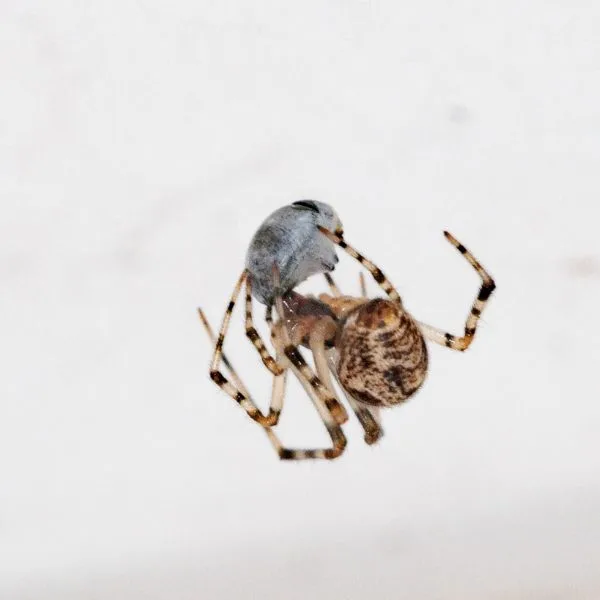
- Experience Level: Beginner
- Family: Theridiidae
- Scientific Name: Parasteatoda tepidariorum
- Other Names: American House Spider
- Adult Size: 3 to 5 mm (0.11 to 0.19 inches)
- Lifespan: 1 to 2 years
- Average Price Range: n/a
The common house spider lives in Pennsylvania and is also found in other parts of the southeastern United States.
This spider’s large range stretches across North America, and they are also found in other parts of the world. Common house spiders live in homes, garages, and other man-made buildings.
The abdomen of a female common house spider’s abdomen is large and round. Males are smaller than females but look very similar.
This species’ color ranges from yellow to dark brown. They have a dark mottled pattern on them, and spindly legs.
Like other similar species, this spider builds messy cobwebs to live in. They feed on small insects like flies, roaches, and mosquitoes.
Since this spider is regularly found in homes it is considered a pest, and even breeds indoors. Since this spider lives in homes they are able to be active year-round.
Females are able to make up to 200 eggs and will create up to 20 egg sacs in their life. While considered a pest some choose to keep this spider in their home as they feed on more annoying animals like various flying insects.
This small species is harmless to humans, and may even go unnoticed in homes for most of their lives.
43. Triangulate Cobweb Spider

- Experience Level: Intermediate
- Family: Theridiidae
- Scientific Name: Steatoda triangulosa
- Other Names: Triangulate bud spider
- Adult Size: 3 to 6 mm (0.1 to 0.23 inches)
- Lifespan: 1 to 3 years
- Average Price Range: n/a
Pennsylvania is not the only place the triangulate cobweb spider is found, it is also found across most of North America.
This spider’s large range also stretches to parts of Europe, Russia, the Mediterranean, and South America. Messy silk webs are created by this species to live in, and also help to catch the food it eats.
Triangulate cobweb spiders have a cream or white coloring, with a dark mottled pattern that appears on their back. Their legs are brown, with dark bands that run down their legs.
This spider’s coloring can range between light or dark depending on the specimen. Male triangulate cobweb spiders have an abdomen around the same size as their head, while females have bulbous ones.
When sitting in its web this spider feeds on the insects that get caught in its silk. Ants, pillbugs, and other spiders are just a few of the things they eat. Finding this spider indoors in places like attics, garages, patios, and other similar places is not uncommon, and they will feed on the pests inside.
Triangulate cobweb spiders are not dangerous to humans, and their venom only threatens the meals it eats. Spring to fall is when this spider is active, and it can be found both inside and outside often.
44. False Black Widow

- Experience Level: Beginner
- Family: Theridiidae
- Scientific Name: Steatoda grossa
- Other Names: brown house spider, cupboard spider
- Adult Size: 10 to 14 mm (0.39 to 0.55 inches)
- Lifespan: 2 to 6 years
- Average Price Range: n/a
The False widow spider is a genus of Steatodoa and gets its name since it looks similar to a widow spider, or Latrodectus species.
This species is a member of the Theridiidae family, or tangle web spider family so the two share common traits. False widows are a common spider in Pennsylvania and live across North America, Europe, Africa, and parts of Asia.
The female false widow has a large rounded abdomen, with thin spindly legs. Males have longer legs and extremely small abdomens.
Females have reddish-brown coloring, and unlike a widow spider, they do not have an hourglass marking on their backs. Females have a cream mottled pattern on there, while males have white markings on their black abdomens.
Messy webs are built by this spider to live in, and since they have poor eyesight they rely on the vibrations of their webs to sense things around them. False widows build their webs near ground level most of the time. On outdoor furniture, near fences, on water spouts, in pipes, and in other secluded places are regular places their webs are made.
Summer and fall are when this species is active the most. They feed on small animals like pill bugs and other spiders.
False widows are not aggressive, and only bite if provoked. Their venom causes mild symptoms like nausea and headaches. Their venom is not as dangerous as the black widow and is mostly used for the small insects it feeds on.
45. Northern Black Widow
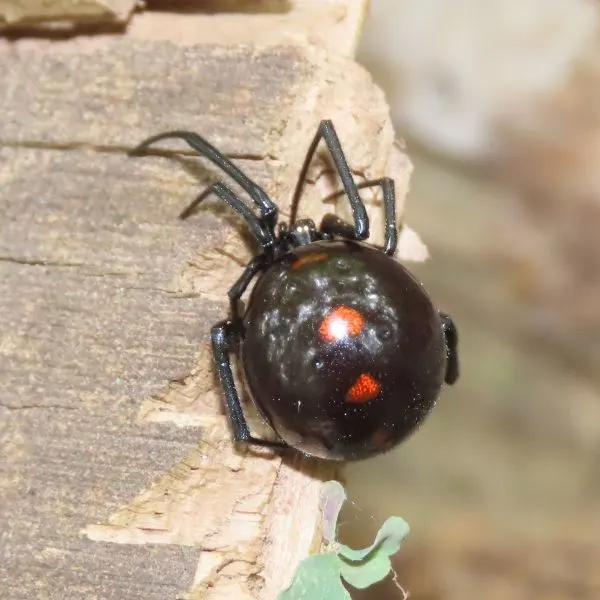
- Experience Level: Intermediate
- Family: Latrodectus variolus
- Scientific Name: Latrodectus variolus
- Other Names: Northern Widow
- Adult Size: 12.7 to 15.24 mm (0.5 to 0.6 inches)
- Lifespan: 1 to 3 years
- Average Price Range: $20
A common spider in Pennsylvania, and other states in the eastern United States, the northern black widow is among the most venomous spiders.
This species is active mostly in the summer and fall months and builds messy webs to live in. Their webs are made in secluded areas like under outdoor furniture, underwater spigots, in children’s toys, and in flower pots.
During the day the northern black widow hides in a hidden area near its web. At night this spider hangs suspended in its web and waits for anything to get caught in its trap.
Flies, woodlice, and other spiders are what this species eats. The northern black widow is a very similar species to the southern black widow, but that species is not found in Pennsylvania.
Northern black widows have an hourglass on the back of their abdomen like other similar species, and they can be told apart from other black widows since their hourglass is broken in its center. Males are much smaller than females and are rarely seen.
Venom from the black widow is around 15 times stronger than rattlesnake venom, but because it is administered in such a small amount it is less deadly. Their venom is neurotoxic, causing symptoms like sweating, vomiting, and dizziness. Deaths from their bite are rare since there is antivenom.
46. American Nursery Web Spider

- Experience Level: Intermediate
- Family: Pisauridae
- Scientific Name: Pisaurina Mira
- Other Names: n/a
- Adult Size: 15 mm (0.59 inches)
- Lifespan: 2 years
- Average Price Range: $10
The American nursery web spider gets its name from the web nursery it builds for its spiderlings, which is where she guards her babies until they are ready to fend for themselves.
Pennsylvania, in woodland and tall grass spider, is where this species is often found. Their range spreads across the eastern United States.
Spring and fall are when this spider is most active, and they also spend their time mating during this period. Females are known for regularly eating their mate.
Males will try to use their silk to wrap the female to avoid becoming food. The female can be seen carrying her egg sac in her jaws. When the eggs are near hatching this species builds a nest for them.
The colors of this species range from gray, to dark brown. This spider has a bold stripe that runs down the center of its body, with a sleek appearance. Their abdomen is pointed, and females are larger than males.
American nursery webs spiders can be seen at night, and feed on the other wildlife in Pennsylvania. Smaller spiders, beetles, and other insects are a few of the things this spider eats.
Like other similar species, this spider is able to walk on the surface of the water. They are common in areas near freshwater sources like lakes and ponds.
47. White-banded Fishing Spider

- Experience Level: Intermediate
- Family: Pisauridae
- Scientific Name: Dolomedes albineus
- Other Names: n/a
- Adult Size: 18 to 23 mm (.7 to .9 inches)
- Lifespan: 2 years
- Average Price Range: $40
One of the few species of fishing spiders that live in Pennsylvania is the white-banded fishing spider. This species lives in areas with water sources and plenty of vegetation.
White-banded fishing spiders are often found near the banks of the water and are able to walk on water to move about. This species is active mostly in the summer and spring.
White-banded fishing spiders have a white or grayish coloring and have a mottled pattern covering them. Below its eyes, there is a white band marking, and they have dark band patterns on its legs.
This spider is active at night and wanders around looking for food. Being a larger species this spider feeds on things like tadpoles, smaller spiders, and various insects.
White-banded fishing spiders are a harmless species to humans, and if spotted they will most likely flee.
48. Dark Fishing Spider

- Experience Level: Intermediate
- Family: Pisauridae
- Scientific Name: Dolomedes tenebrosus
- Other Names: n/a
- Adult Size: 6.8 to 25.4 mm (0.27 to 1 inch)
- Lifespan: 2 years
- Average Price Range: n/a
Dark fishing spiders are a large species found in forest and woodland habitats in Pennsylvania. This spider lives in freshwater habitats like lakes, or ponds, but is a fishing spider that is regularly found away from water.
This species is often confused for a wolf spider because of its large size, and furry appearance. Dark fishing spiders have tan coloring, with a mottled pattern on them.
Summer and fall are when this spider is most active, and also mates during this season. The dark fishing spider is sometimes seen in this period carrying its egg sac in its mouth.
When the eggs are ready to hatch this spider puts them in a hidden area and watches its spiderlings until they are ready to fend for themselves. Dark fishing spiders are seen most in the late spring and summer months.
This spider is active at night and feeds on things like other spiders, insects, and small frogs. Birds and large lizards are the main predators this species faces.
49. Six-spotted Fishing Spider
- Experience Level: Intermediate
- Family: Pisauridae
- Scientific Name: Dolomedes triton
- Other Names: Dock Spiders
- Adult Size: 15 to 60 mm (0.59 to 2.3 inches)
- Lifespan: 2 years
- Average Price Range: $20
The six-spotted fishing spider is one of the many nursery web spider species that live in Pennsylvania.
This spider is named after the six spots that appear on the underside of its abdomen, but they also have spots on its back. This spider has tan coloring with white and dark stripes running down the sides of its body.
Fishing spiders like this species are also called dock spiders since they are found regularly around docks. This spider lives in habitats like forests, swamps, and meadows.
They are semi-aquatic spiders that can walk across the surface of the water like a god. This species walks on the water to escape predators or catch prey. They are most active in the spring and fall months.
Six-spotted fishing spiders feed on animals like tadpoles, small insects, and animal eggs. They are an active hunter like the wolf spider or jumping spider, and do their hunting at night.
In Pennsylvania finding this spider near the water on a warm night is not uncommon.
50. Rabid Wolf Spider

- Experience Level: Beginner
- Family: Lycosidae
- Scientific Name: Rabidosa rabida
- Other Names: n/a
- Adult Size: 13 to 21 mm (0.511 to 0.82 inches)
- Lifespan: 1 to 4 years
- Average Price Range: $40.00
Rabid wolf spiders are a species of Lycosidae that lives in Pennsylvania. This spider lives in woodlands and fields.
They are more common in places with a freshwater source like a pond or lake. In burrows under debris is where this species builds its home.
Mating for wolf spiders requires males to do a dance, and make noises for the female. Rabid wolf spiders are one of the few species in Pennsylvania, and the world carries their egg sac on their mouths, and their spiderlings on their back when they hatch.
This spider is medium-sized and has tan coloring. They have dark bold stripes that appear on their cephalothorax, and abdomen. The eyes of this species are all placed on their face, and when they glow when shined with a light in the night.
This species is native to North America and feeds on the small animals it comes across. Rabid wolf spiders do not use webs to catch prey but hunt them down like a wolf.
51. Tiger Wolf Spider

- Experience Level: Beginner
- Family: Lycosidae
- Scientific Name: Tigrosa helluo
- Other Names: Wetland Giant Wolf Spider
- Adult Size: 6.3 to 50 mm (0.24 to 1.9 inches)
- Lifespan: 1 to 4 years
- Average Price Range: $20 to $40 dollars
Tiger wolf spiders are one of the largest spiders you can find in Pennsylvania. This spider is a member of the wolf spider Lycosidae family.
They are seen most in the fall and spring months of the year. Tiger wolf spiders are other similar species that can be found all year except winter when they die off of rest until spring comes.
A very large species, this spider has tan coloring and orange markings that cover its body like a tiger. Some spiders may be dark and look closer to black than tan. A mottled pattern covers them, as well as many small hairs.
Tiger wolf spiders live in burrows or hide under debris like logs or rocks. This spider is mainly active at night and spends this time looking for food.
Wolf spiders are named after their wolf-like ferocity when hunting. They feed on small insects like beetles, and other spiders, and will even eat frogs.
This spider feeds on anything small enough it comes across and uses its venom to neutralize its prey.
FAQ
What Dangerous Spiders Live in Pennsylvania?
The black widows are Pennsylvania’s most dangerous spider and are native to the state. Other dangerous spiders like the brown recluse may be brought in through states by traveling through trade, but cannot survive in the state’s climate.
Black widow bites occur most from spring to early fall, and symptoms are mostly mild. Nausea, headache, cramping, and tremors are some of the reported symptoms of their bite, but anti-venom exists.
When Are Spiders Most Common in Pennsylvania?
Each species in Pennsylvania has its own preference for when it prefers to be active, but most spiders can be seen from the months of spring to fall.
In the autumntime, spiders may make their way into homes to try to escape the cold. Winter older spiders die off, while the younger spiders and eggs become dormant until the season is right.
What Are Pennsylvania’s Largest Spiders?
The largest species of spider that lives in Pennsylvania is the wolf spider.
This species gets its name from its wolf-like hunting ability and regularly feeds on small animals like other spiders or small frogs in the habitats they live in. The tiger wolf spider is one of the largest species of wolf spiders that live in Pennsylvania, and some get larger than an inch in size.
Wrapping up
Spiders in Pennsylvania are an important part of the state’s ecosystem but are also interesting to watch. This article covered 51 species that live within the state, but there are many more to be found in the wild.
The United States alone has more than 3,500 species, and there are more than 45,000 species found across the globe. The spiders in Pennsylvania are just a few in the wild, and new species are discovered regularly.
Even with the abundance of species, most are harmless, and some like jumping spiders even make great pets. Learning about spiders helps you know which ones are dangerous, and gets you a view of the interesting lives they live.
The spiders in Pennsylvania and other parts of the United States all play their part in keeping pest insect populations down and are also valuable food to the native wildlife that eats them.
